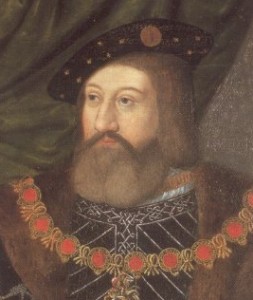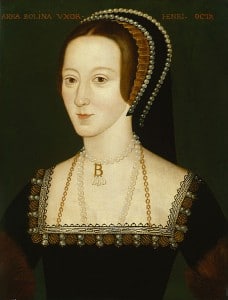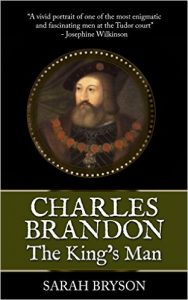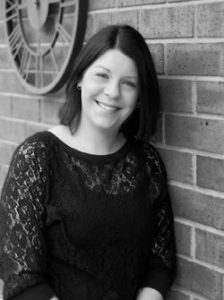 To celebrate the release of her biography of Charles Brandon, Charles Brandon: The King’s Man, Sarah Bryson is joining us today with a guest article on Brandon and Anne Boleyn. Thank you, Sarah, and good luck with your book!
To celebrate the release of her biography of Charles Brandon, Charles Brandon: The King’s Man, Sarah Bryson is joining us today with a guest article on Brandon and Anne Boleyn. Thank you, Sarah, and good luck with your book!
Queen Anne Boleyn, second wife of King Henry VIII, and Charles Brandon, Duke of Suffolk, had never seen eye to eye. Brandon was the King’s childhood friend. He had grown up with Henry, sharing his teenage desires and adventures, and ultimately forming a close bond that would sustain many ups and downs. Anne Boleyn was to become Henry VIII’s second wife, his passionate lover, the woman he waited seven years to marry and broke with Rome to make his queen. Brandon and Anne were headed on a collision course, both vying for the King’s attention. Only one would survive.
The first signs of unrest between Brandon and Anne may have appeared indirectly from Brandon’s third wife, Mary Tudor, Henry VIII’s younger sister and a close friend of his first wife, Katherine of Aragon. When Henry openly separated from Katherine in 1531 Mary disapproved and removed herself from court.
Brandon may have shared similar feelings as his wife. Clearly he was not impressed with Anne Boleyn and her new position at court and sought to discredit her. Eustace Chapuys, ambassador to Charles V, wrote to his master that Anne “had been accused by the Duke of Suffolk of undue familiarity with a gentleman who on a former occasion had been banished on suspicion.” This gentleman was Sir Thomas Wyatt, poet, courtier and long-time friend of the Boleyn family. His poetry suggests that he had a crush on Anne, but there is no evidence to suggest that Anne returned his feelings. While there turned out to be no truth in this rumour, Henry was furious at his best friend and banished him from court for a time. In retaliation for this accusation, Anne Boleyn made one of her own declaring that Brandon was sleeping with his daughter. Despite being banished from court, Brandon spoke with the treasurer of the King’s household, William Fitzwilliam, in the hope of working with him to persuade the King against marrying Anne Boleyn.
It may have been that Brandon genuinely did not believe Anne Boleyn to be suitable for the position of queen. Katherine of Aragon had been a Spanish Princess, raised from birth to become a queen. Anne Boleyn was an earl’s daughter who had previously served Katherine. With his wife firmly supporting the rejected Katherine of Aragon, Brandon may have sought to align his feelings with Mary and to discredit Anne.
Another reason for Brandon’s dislike of Anne may have been her link to the Duke of Norfolk. Thomas Howard, 3rd Duke of Norfolk, was Anne Boleyn’s uncle, and Brandon and Norfolk had never seen eye to eye. The pair had often squabbled over minor matters at court and often sought to outdo one another. With Anne Boleyn on the ascent, this would also mean a rise for her family and in turn greater influence for her uncle. Brandon may have simply used Anne as a means of attacking Norfolk’s growing power.
In 1532, things went even further when Brandon’s wife spoke publicly about her opposition to the marriage and where her loyalties lay, speaking about Anne Boleyn in unfavourable terms. This resulted in a quarrel between some of the Duke of Norfolk’s men and Brandon’s men. On 23 April, Carlo Capello reported that:
At the moment of his arrival at the Court, one of the chief gentlemen in the service of said Duke of Norfolk, with 20 followers, assaulted and killed in the sanctuary of Westminster Sir (D’no) William Peninthum (sic) chief gentleman and kinsman of the Duke of Suffolk. In consequence of this, the whole Court was in an uproar, and had the Duke of Suffolk been there, it is supposed that a serious affray would have taken place. On hearing of what had happened, he (Suffolk) was on his way to remove the assailants by force from the sanctuary, when the King sent the Treasurer [Thomas Cromwell] to him, and made him return, and has adjusted the affair; and this turmoil displeased him. It is said to have been caused by a private quarrel, but I am assured it was owing to opprobrious language uttered against Madam Anne by his Majesty’s sister, the Duchess of Suffolk, Queen Dowager of France.( Calendar of State Papers Venice Vol. 4 761).
The murderers were pardoned and then in 1533 the Duke of Norfolk demanded that Brandon relinquish the office of Earl Marshal – which Brandon had held since the death of Norfolk’s father in 1524 – to Norfolk. Henry VIII complied with this request and in turn granted Brandon the office of Warden and Chief Justice of the royal forests south of Trent. This loss of position may have furthered Brandon’s resentment of Norfolk and added to his growing disdain for Anne Boleyn.
After these events, Brandon and Mary removed themselves from court and it took the influence of Thomas Cromwell and even a visit from the King to smooth things over. The Duke of Norfolk had won this round but Brandon had learnt a valuable lesson. He would keep this thoughts and opinions to himself rather than risk losing the King’s favour.
 On Sunday 1 June 1533, Anne Boleyn was crowned Queen of England. Wearing a gown of crimson velvet edged in ermine and a purple velvet mantle, and her hair loose, Anne made the journey barefoot from Westminster Hall to Westminster Abbey under a canopy of cloth of gold. Brandon was to play a role in Anne’s coronation, as Lord High Steward, and it was his duty to walk before the future Queen carrying her royal crown. During the coronation, he stood close to the Anne holding his white staff of office. Afterwards, a great banquet was held at Westminster Hall where Brandon acted as Lord High Steward and Constable. It was his responsibility to organise all the details of the coronation, including Anne’s procession through London the previous day. Wearing a doublet covered in pearls and riding a charger covered in crimson velvet, Brandon rode through the banquet consisting of eight hundred people and approximately thirty-two dishes. However much Brandon may have personally disapproved on the marriage he did his duties to the fullest and for now bided his time.
On Sunday 1 June 1533, Anne Boleyn was crowned Queen of England. Wearing a gown of crimson velvet edged in ermine and a purple velvet mantle, and her hair loose, Anne made the journey barefoot from Westminster Hall to Westminster Abbey under a canopy of cloth of gold. Brandon was to play a role in Anne’s coronation, as Lord High Steward, and it was his duty to walk before the future Queen carrying her royal crown. During the coronation, he stood close to the Anne holding his white staff of office. Afterwards, a great banquet was held at Westminster Hall where Brandon acted as Lord High Steward and Constable. It was his responsibility to organise all the details of the coronation, including Anne’s procession through London the previous day. Wearing a doublet covered in pearls and riding a charger covered in crimson velvet, Brandon rode through the banquet consisting of eight hundred people and approximately thirty-two dishes. However much Brandon may have personally disapproved on the marriage he did his duties to the fullest and for now bided his time.
In the last weeks of April 1536, a coup swept through the court that saw the death of Anne Boleyn and five innocent men. On 24 April, two commissions of oyer and terminer were set up at Westminster by Thomas Cromwell and Sir Thomas Audley, Henry VIII’s Lord Chancellor. A jury of noblemen, including Charles Brandon, were presented with a list of offences against the King committed in both Middlesex and Kent. While examining the various offences, the jury found enough damning evidence against Anne Boleyn to try her for committing adultery with Sir Henry Norris, Francis Weston, William Brereton, Mark Smeaton and George Boleyn, Lord Rochford, her brother, as well as plotting to have her husband, the King of England, killed.
Anne Boleyn was arrested on 2 May 1536 and taken to the Tower, lodged in the Queen’s apartments where she had been housed the night before her coronation. Then, on 15 May, Brandon was amongst the jurors who were selected to try George Boleyn, Lord Rochford, and Anne Boleyn herself.
Hundreds of people came to the Tower to see Anne Boleyn’s trial – for the very Queen of England to be tried for adultery, incest and treason was surely no light matter! The charges were read to Anne, every sordid, horrible, scandalous detail of her alleged adultery and treason. It is said that throughout this indignity Anne sat, poised and beautiful, showing no sign of disgust or guilt. After this she was asked how she pleaded, the Queen replied that she was not guilty of any of the charges.
Despite defending herself nobly, it was to no avail. One by one, each member of the jury stood and gave their verdict – every man said ‘guilty’, including Charles Brandon. Anne Boleyn, Queen of England, had been found guilty of all the charges presented before her: adultery, incest and treason.
It has been proposed that the charge of incest against Anne Boleyn was brought forward by Brandon. Previously, Anne had declared loudly that Brandon had slept with his daughter. Was the suggestion of incest with her brother Brandon’s way of getting back at Anne for her comment? Or was it simply a means to rid the court of George Boleyn, a powerful man in his own right? Either way, Brandon was no fool. He had learnt his lesson against standing up to the King and knew that his title, his lands, and his very position at court were reliant upon the King’s favour. As at so many times previously, Brandon did his duty and found both Anne and George Boleyn guilty.
On 19 May 1536, around 9am, Anne left her chambers in the Queen’s lodgings for the last time. Anne walked down the stairs from the Queen’s lodgings to the courtyard between the Jewel House and the King’s Hall. Two hundred Yeomen were there to lead Anne, her ladies-in-waiting, Sir William Kingston and several others to the scaffold that had been erected. She walked through the courtyard and then through the twin towers of the Coldharbour Gate to the scaffold that awaited her. Reports state that approximately a thousand people surrounded the scaffold upon Tower Green to watch the execution of Anne Boleyn. Two men in that crowd were Thomas Cromwell, who some suggest was behind Anne’s fall, and, of course, Charles Brandon, Duke of Suffolk.
With one stroke of the French executioner’s sword, Anne Boleyn’s head was cut from her body and her life ended. In one swift stroke, Brandon’s rival was no more. Certainly there was a rivalry between the pair, both fighting for Henry VIII’s attention and both slinging insults at one another seeking to discredit the other. But what did Charles Brandon think and feel in regards to Anne’s fall from power and ultimate execution? Sitting on the jury, he must have seen through the allegations brought against Anne if we can do so 500 years after the event. Did he feel remorse or did he simply do his duty knowing that much of what he had was reliant upon the King’s favour? We may never know Brandon’s true feelings towards Anne at the end of her life but with her death, his rival was gone.
Charles Brandon: The King’s Man
 Charles Brandon was an enigmatic, charismatic man, rising from a mere boyhood friend of the future king, Henry VIII, to flirting with a European duchess, marrying Mary Tudor, Dowager Queen of France, and being created Duke of Suffolk. Brandon was one of the best jousters during the reign of Henry, he was clever, athletic and confident, though his confidence sometimes got him into trouble.
Charles Brandon was an enigmatic, charismatic man, rising from a mere boyhood friend of the future king, Henry VIII, to flirting with a European duchess, marrying Mary Tudor, Dowager Queen of France, and being created Duke of Suffolk. Brandon was one of the best jousters during the reign of Henry, he was clever, athletic and confident, though his confidence sometimes got him into trouble.
In this detailed biography, Sarah Bryson (Mary Boleyn in a Nutshell) gives us a highly detailed look at Charles Brandon’s life and times, including information and background on each of his marriages, his children, and his lifetime achievements.
Fully referenced and indexed, Charles Brandon: The King’s Man is an invaluable resource for any Tudor enthusiast.
“A vivid portrait of one of the most enigmatic and fascinating men at the Tudor court.” – Josephine Wilkinson, author of Katherine Howard
“An enjoyable and readable biography of this fascinating Tudor man.” – Claire Ridgway, author of The Fall of Anne Boleyn
“Bryson has constructed a fluid and well-informed narrative which rings with passion for her subject. She successfully brings to life a vibrant and complex man, drawing out the different levels of his identity as a courtier, jouster, politician, friend to the King and as a husband and lover. I defy anyone to read this interesting study and not to be drawn in by the author’s infectious desire to understand the real Charles Brandon.” – Amy Licence, author of The Six Wives & Many Mistresses of Henry VIII
Charles Brandon: The King’s Man is available as a paperback and kindle book from:
- Amazon.com – Kindle book
- Amazon.co.uk – Kindle book
- Amazon.com – Paperback book
- Amazon.co.uk – Paperback book
and other Amazon stores. It will also be available as a paperback from other book retailers.
Sarah has also written an article for QueenAnneBoleyn.com, who are having a special Charles Brandon day in celebration of the release of Sarah’s book today, “Charles Brandon and Mary Tudor: Forbidden Love” – click here to read that now.
 Sarah Bryson is a researcher, writer and educator who has a Bachelor of Early Childhood Education with Honours. She currently works with children with disabilities. She is passionate about Tudor history and has a deep interest in Mary Boleyn, Anne Boleyn, the reign of Henry VIII and the people of his court. Visiting England in 2009 furthered her passion and when she returned home she started a website, queentohistory.com, and a Facebook page about Tudor history. Sarah lives in Australia, enjoys reading, writing and Tudor costume enactment, and wishes to return to England one day.
Sarah Bryson is a researcher, writer and educator who has a Bachelor of Early Childhood Education with Honours. She currently works with children with disabilities. She is passionate about Tudor history and has a deep interest in Mary Boleyn, Anne Boleyn, the reign of Henry VIII and the people of his court. Visiting England in 2009 furthered her passion and when she returned home she started a website, queentohistory.com, and a Facebook page about Tudor history. Sarah lives in Australia, enjoys reading, writing and Tudor costume enactment, and wishes to return to England one day.
Sources
- Bryson, S (2016) Charles Brandon: The King’s Man, MadeGlobal Publishing.
- Calendar of State Papers Relating To English Affairs in the Archives of Venice, Volume 4, 1527-1533, Her Majesty’s Stationery Office, London, 1871.
- Gunn, S (2015) Charles Brandon, Amberley Publishing, Gloucestershire, UK.
- Hume, M (1905), The Wives of Henry the Eighth and the Parts They Played in History, Eveleigh Nash, London.
- Letters and Papers, Foreign and Domestic, of the Reign of Henry VIII, 1509-47, ed. J S Brewer, James Gairdner and R H Brodie, His Majesty’s Stationery Office, 1862-1932.
- Loades, D (2012) The Tudors: History of a Dynasty, Continuum International Publishing Group, London.
- Loades, D (2012) Mary Rose, Amberley, Gloucestershire.
- Weir, A (2009) The Lady in the Tower: The Fall of Anne Boleyn, Jonathan Cape, London.